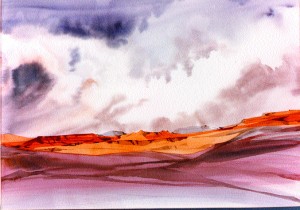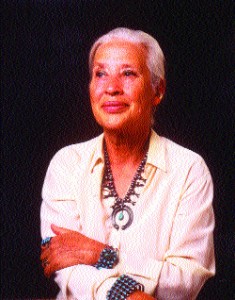By Marilyn Noble
She’s a tiny woman with twinkling eyes and a ready laugh, but you can’t let Jeannie Pear fool you. Her soul is as deep and wide as the New Mexico sky, and she expresses it through her paintings of the people, places and animals she loves.
Pear was born in 1922, in Las Vegas, N.M., the daughter of two homesteading families who settled in the open plains of Eastern New Mexico before it was a state. Her father’s job brought the family to Denver when she was only three, but the essence of the high desert was already imprinted on her heart.
“It’s part of me; it’s in my molecules,” she says with a chuckle.

Dineh” an offset lithograph commissioned by John Manville as a coporate gift for visitors to their world headquaters in Denver.
Growing up in Denver, Pear was surrounded by creativity. Her mother was an accomplished potter and her father was a jazz musician, so it was only natural that they encouraged her artistic endeavors. One of her first instructors was renowned painter Vance Kirkland. She later studied at Colorado Women’s College, Corcoran Institute of Art and the University of Denver.
She began her career as a fashion illustrator, first in Denver and then in Washington D.C. Pear met her husband Bert when he was a “dashing fellow in uniform” stationed at Lowry, and after the wedding, returned with him to his hometown of Washington so that he could pursue a career as a reporter for the “Times Herald.”
“One day he came home and said he was going to medical school,” she recalls. “Well, I never wanted anything to do with being a doctor’s wife, but it was too late to back out, so I just went with it.”
He accepted a radiology residency at the University of Colorado Medical Center, so the couple returned to Denver where Pear did freelance illustration work and raised their two children, Jeffrey and Melissa. Jeffrey was born with brain damage, and only lived to be five.
“He was a wondrous little fellow, and he brought us so much joy,” said Pear. Jeffrey’s image still occasionally surfaces in Pear’s work.
Once her daughter began school, Pear started to paint what was in her heart. Her first subjects were mothers and children, but she avoided the temptation to gloss over her subjects and make them overtly sentimental.
“Children are confronted with the vicissitudes of life, both good and bad, but they don’t have the armor to hide like we do as adults,” she says. “I wanted to capture that, and paint them as they really are.”
It wasn’t until 1974 that Pear began to paint the American West. Johns Manville Corporation bought Ken Caryl Ranch, which was still a working operation at the time, and hired Pear and her friend, Rosemarie Stewart, to gather a group of artists to visually document the land and its history. Pear stirred up the interest of about a dozen of her artist friends, including George Carlson and Buffalo Kaplinski.
“I had always thought most western art was tacky, but when they asked me to be the token woman, and told me I could paint any subject I wanted in any medium, I thought that was a pretty good deal, so I said yes,” Pear said.
Her first subject was the ranch foreman, a man who was much more comfortable on the back of a horse than he was sitting in Pear’s studio. She enjoyed painting him so much, capturing both his strength and his gentleness, that she began to visit the ranch to paint the animals.
“The whole experience trapped me,” she says. “Painting those big shiny animals, and the horses—I just loved it.”
One day, she was sketching the backside of a 2,500-pound bull, when he turned and snorted at her.
“I said ‘Shut up, fatso,’ and he turned and charged the fence,” she said. “I ran for my life, even though he couldn’t get at me. The cowboys all laughed so hard.”
Captivated by the bull’s overwhelming power and raw emotion, Pear took her art in a whole new thematic direction, further exploring the western landscape and its inhabitants. A few years later, Pear heard a knock on the gate of her second home in Santa Fe. The visitor was Father Clifford Stevens, a Catholic priest who wanted to rent the studio in the back of the house for one of his seminarians. While the studio wasn’t for rent, the Pears were having a cocktail party and invited the priest to join them.
“He said, ‘Why leave the gaiety to the laity?’ so he came in and we became great friends,” she said.
The Pears collected Spanish colonial antiques, and owned a centuries-old vestment chest. Father Stevens wanted to say Mass in their home using the chest as an altar, and even though they were Episcopalians, they agreed. The priest asked Pear if she would paint a banner for the celebration, the Feast of Angels, so she found some silk and painted a shimmering angel to hang over the altar.
“We were a rag-tag bunch that gathered for that Mass,” she laughs. “A couple of them were divorced and lapsed Catholics, but Father Stevens told us we all shared the same God, and that everyone would have communion that day. So we did, and then the poor man went home and had a migraine for three days.”
Once again, she found herself drawn to a new theme in her art that seemed inspired from deep in her soul. “Both the horses and the liturgical art have such power and drama to them,” she says. “I never wanted to do decorative stuff. I have to say something, to express the emotions of my inner world.”
Her liturgical banners and paintings hang in churches, cathedrals and monasteries all over the southwest, and Pear has showed her landscapes and portraits at galleries and exhibitions in Denver, Santa Fe and Tucson. In 1998, her work was included in “An Encyclopedia of Women Artists of the American West,” by Phil Kovinick and Marian Yoshiki-Kovinick (University of Texas Press, Austin).
While she has illustrated books of poetry—”powerful, probing, exciting works”—written by fellow New Mexicans Peggy Pond Church and her friend, Father Stevens, Pear’s favorite projects were two children’s books written by Andrea Bacigalupa. She was introduced to him by a mutual friend, children’s author and Newberry Award winner Mia Wodjekowsca, and became enchanted by his stories.
“They’re delightful kid’s books, full of warm humor, and working on them was wonderful,” she says. “I got to draw all of the things of New Mexico that I love.”
The books, “A Good and Perfect Gift” and “Song of Guadalupana,” were published in the late 1970s and are now out of print, but they remain the highlight of Pear’s long and fruitful career.
Pear continues to paint every day and shows no signs of slowing down.
“Good heavens, I need another 80 years to do everything I want to do,” she laughs.
Her latest work, a series of watercolors of northern New Mexico villages, is available through Canaan Gallery at Southglenn Mall.
For more information,
call (303) 794-6945.














